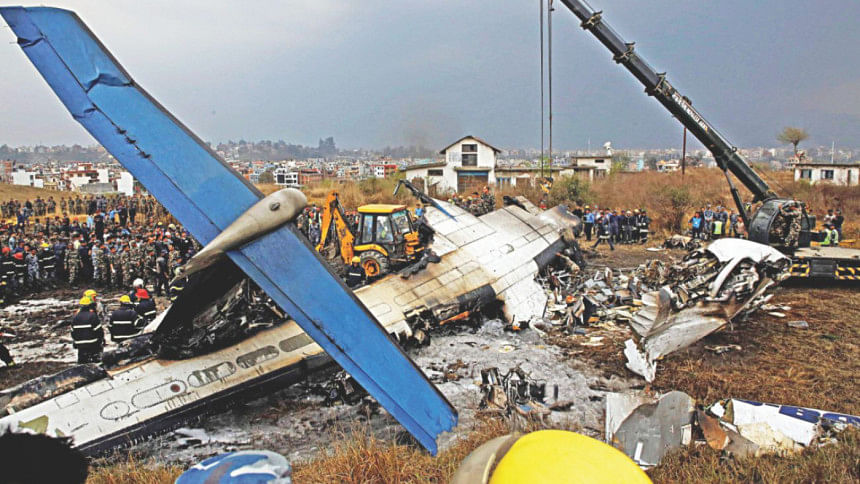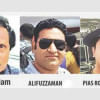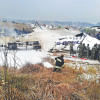US-Bangla Plane Crash: Pilot error vs tower error

The captain of the US-Bangla plane "seemed to have an emotional breakdown" before the crash in Kathmandu airport last March, Nepali investigators said in the final report published yesterday.
They blamed pilot Capt Abid Sultan, 52, and First Officer Prithula Rashid, 25, of losing situational awareness at a critical phase of flight BS211 to Kathmandu from Dhaka on March 12, 2018. The Bombardier Dash-8 Q400 crashed on a football pitch beside the runway and caught fire killing 52 of the 71 on board.
But, Capt Salahuddin M Rahmatullah, Bangladeshi member of the Accident Investigation Commission formed by Nepal, yesterday said had the people at Air Traffic Control (ATC) of Kathmandu's Tribhuvan International Airport performed their duties properly, the crash could have been averted.
" … above all, there was the absence of a last-minute ATC instruction or advice for corrective action that the flight crew could have taken to avoid the accident," said Salahuddin, also the head of the Aircraft Accident Investigation Group of CAAB, at a press briefing hours after the Nepali authorities published the report.
Officials of the ATC took cover under their tables seeing the aircraft's flight path and this aspect of the incident was omitted in the final investigation report, he said during the briefing at the headquarters of Civil Aviation Authority of Bangladesh (CAAB) at the city's Kurmitola.
He said he had made six observations about the negligence of the Kathmandu ATC that were not incorporate in the final report compiled by the Nepali officials.
Salahuddin, who led a six-member Bangladeshi team to assist the Nepalese investigation body, said he would urge the Nepali authorities to include these aspects as appendix to the report.
"If Nepal fails to incorporate, Bangladesh will go to the International Civil Aviation Authority in this regard," he said.
There was a mistake on part of the pilot but if the ATC had addressed the matter properly, then that mistake could have been corrected, he said.
"An instant and executive advice by the ATC Controller to the pilot to discontinue landing and climb up straight ahead at the very last moment, or words to that effect, just prior to its touchdown, could have contributed positively to evade the accident," said Salahuddin in his observation.
"The ATC controllers, who had the aircraft in visual at all times, as per their admission during interrogation, did not contribute to regulate the aircraft's flight movements in the right direction" even though a local pilot judging the aircraft's manoeuvre had advised the ATC that the cockpit crew appeared disorientated.
The local pilot even advised the ATC to guide the US-Bangla plane out of the area that had poor visibility, said Salahuddin, adding that the ATC was silent and played the spectator's role when the plane was manoeuvring dangerously in the valley.
Initially, BS211 was controlled by an Over Job Training (OJT) staffer of the Tribhuvan ATC who could have noticed the plane's deviation from the path of Runway 02 and inform the aircraft, but that did not happen, he said.
No evidence was found to ascertain if the staffer had seen the aircraft's position on short final. He said the ATC staffer could have instructed a missed approach and go-around procedure as there was ample opportunity to do so.
Talking to The Daily Star, US-Bangla Airlines CEO Imran Asif said the investigation report was "inadequate" as the ATC's negligence had been underplayed.
Earlier in the day, the Nepali investigators in the final report on the Himalayan nation's worst aviation disaster in 26 years said the captain was under stress and "emotionally disturbed" because he felt that a female colleague who was not on board the fatal flight had questioned his reputation as a good instructor, Reuters reported.
"The pilot thought he could manoeuvre the aircraft and land. But he could not," panel official Buddhisagar Lamichhane, told Reuters.
"This, together with the failure on part of both the crew members to follow the standard operating procedure at the critical stage of the flight, contributed to the loss of situational awareness," read the report.
This lack of awareness meant the crew did not realise the deviation of the aircraft from its intended path, which in turn meant they could not see the runway, it added.
Having missed the runway, the plane flew very low in the north of the runway at an incorrect position near hilly and mountainous terrain, it said.
"Finally, when the crew sighted the runway, they were very low and too close to [it] and not properly aligned," added the report, saying the captain should have halted the landing and initiated a go-around.
The plane skidded off the runway on to surrounding grass, quickly catching fire. Both pilots were among those killed. The accident left 29 Bangladeshis, including the cockpit crew, 22 Nepalese and one Chinese dead.
Capt Abid was released in 1993 from the Bangladeshi Air Force because he suffered from depression but was later declared fit to fly commercial planes, the report said citing recent medical reports mentioning no symptoms.
Citing the cockpit voice recorder and accounts of passengers, the report said the captain was smoking in the cockpit during the flight and "engaged in unnecessary, unprofessional and lengthy conversation even in the critical phase," violating the norms of maintaining a sterile cockpit.
His first officer had 390 hours of flying experience and no experience in landing at Kathmandu as a crew member.
The disparity in experience and added authority of the captain probably deterred the first officer from being more assertive during significant phases such as the final approach and landing, the report said.
Landing at Kathmandu airport, surrounded by hills, is considered difficult, the report said. In 1992, all 167 on board a Pakistan International Airlines plane were killed when it slammed into a hill trying to land.
RECOMMENDATIONS
The report recommended that the airlines give emphasis on proper crew resource management and set up a mechanism to monitor and assess the mental status of the crew regarding professional development, financial, personal, and psychological issues.
Pilot's mental health became the spotlight after a Germanwings first officer deliberately flew a jet into a mountain in 2015.
Last year, the European Commission adopted new rules that make it mandatory for airlines to do a psychological assessment before hiring pilots.
The probe commission in its recommendations to the Civil Aviation Authority of Nepal said CAAN should strengthen the capacity of the ATCs, by developing the appropriate training programmes so that they become more assertive when handling the air traffic and issuing clearances to such traffic especially in the event of abnormal or emergency situations.
The ATC should be more vigilant and shall visually look out for the aircraft, when the weather permits, after the landing clearance has been issued, it said.
In the nine-point recommendation to the US-Bangla Airlines, the commission suggested that the carrier should establish and implement a policy to de-roster any crew member found to be stressed, fatigued or emotionally disturbed.
To CAAB, the commission recommended that it makes thorough periodic physical and psychological assessment of permanently grounded pilots before renewing their licences. A system should be adopted to monitor the medical condition closely in all subsequent medical examinations as well, it said.

 For all latest news, follow The Daily Star's Google News channel.
For all latest news, follow The Daily Star's Google News channel. 





Comments